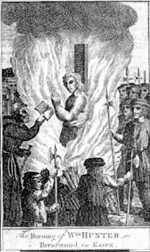
|
A Protestant Martyr at Brentwood - William Hunter, 1555 On Tuesday 27 March 1555 the nineteen year old William Hunter, who was an apprentice silk weaver in London, was publicly burned in his home town of Brentwood. He was the first Essex martyr of the reign of Mary Tudor, when England officially returned to the Papal fold. He had refused to go to Mass at his master's bidding and had been sent back home. He was found in Brentwood Chapel reading the Bible for himself.80 Hunter had been given several opportunities to recant of these heresies. Neither fair words nor a sentence of nine months in heavy irons could weaken his 'obstinacy'. Hunter declined Bishop Bonner's' offer of £40 to set him up in business and to make him a Freeman of the City of London, if only he would recant. Others were less principled. Lord Rich who had accommodated himself to the religious views of Henry VIII, became a Protestant under Edward VI and a persecutor of Protestants under Mary. Some retired to their estates, like Sir Thomas Smyth at Theydon Garnon and passed his time in literary work until better days should come. Hunter was not afraid to die, lifting his hands to heaven and praying: 'Lord receive my spirit', then casting down his head again into the smothering smoke, he yielded up his life for the Faith'. This account of Hunter's martyrdom comes from Foxe,J., Acts and Monuments of these Latter and Perilous Days. Known as Foxe's Book of Martyrs this work was published in English in 1562-3 'for the information of the multitude'. The vivid engravings were added later. The martyrologist, John Foxe, lived for a time in Waltham Holy Cross, Essex and while, according to Fuller, he was preparing his large and learned works. But Foxe was one of those who chose to go into exile rather than live in Marian England. By order of Convocation of the Church in England in April 1571, Foxe's Book of Martyrs 'should be placed in cathedral churches and in the house of archbishops, bishops, deacons and archdeacons'. This order was liberally interpreted and many clergymen arranged things as at St.Michael's Cornhill where on 11 January 1572 'it was agreed that the Book of Martyrs of Mr.Foxe and the Paraphrases of Erasmus shall be bought for the church and tied with a chain to the eagle brass'.81 Roman Catholics were angered by the publication. They nick-named it Foxe's 'Golden Legend' attacked its inaccuracies and expressed disgust that the Protestant martyrs took the place of the old saints.
|
||||
 |
